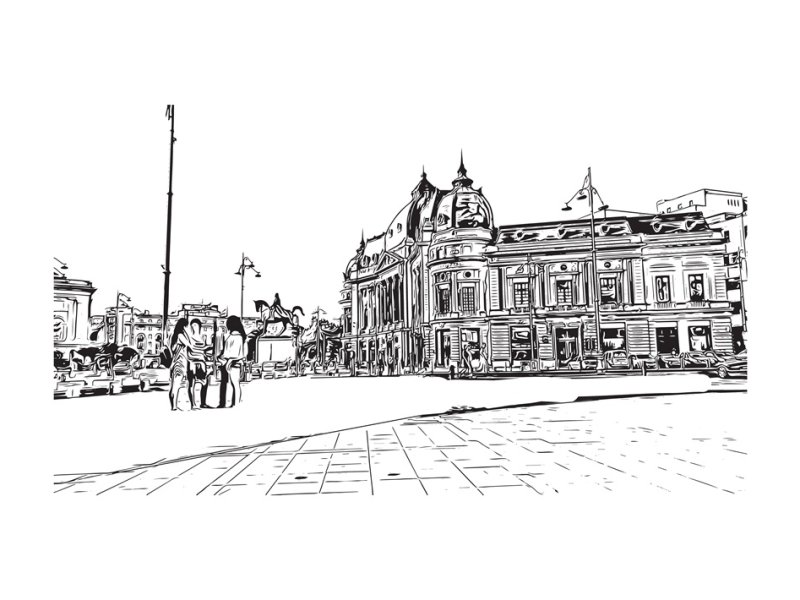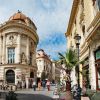Top 5 buildings and districts that were erased without us even noticing

By Bucharest Team
- Articles
5 Historic buildings and areas of Bucharest that disappeared quietly, yet irreversibly
In Bucharest, not all demolitions happen under the roar of bulldozers. Some losses are slow, silent, and permanent. Whether in the name of modernization, urban reorganization, or political ambition, the city has lost significant pieces of its architectural identity. Below are five emblematic examples — each revealing a different side of collective amnesia and urban neglect.
1. Uranus Neighborhood – a deep rupture in the city’s historical fabric
Among all the transformations Bucharest has undergone, the systematization of the 1980s remains the most destructive. The Uranus district — a dense mix of 18th- and 19th-century houses, churches, gardens, and small workshops — was razed to make way for the Civic Center and the Palace of the Parliament.
Roughly 9,000 buildings were demolished, more than 50,000 residents displaced, and 22 churches erased. Some churches, like Mihai Vodă, were relocated on tracks, while others, like Spirea Veche, were completely destroyed. What was lost is not only architectural richness, but also layers of memory and social fabric.
Source: The term “Ceaușima” was coined by architect Dan Marin to describe this violent erasure of urban identity.
2. Văcărești Monastery – a Brâncovenesc masterpiece erased in days
Built between 1716 and 1736 by Prince Nicolae Mavrocordat, Văcărești Monastery was once the largest monastic complex in Southeastern Europe, a brilliant example of the Brâncovenesc architectural style. It served various roles across centuries — monastery, fortress, and eventually prison — yet its walls and frescoes survived until the mid-1980s.
In 1984, under the pretext of building a new Palace of Justice, the entire complex was demolished. The project was never completed. Today, only fragments of the original site remain, scattered in museums or absorbed into newer constructions.
The loss was documented photographically by architect Augustin Ioan and art historian Alexandru Beldiman.
3. The Grand Spanish Synagogue (Cahal Grande) – a community erased along with its landmark
Built in 1818, the Cahal Grande Synagogue was the spiritual center of Bucharest’s Sephardic Jewish community. Known for its elegant interior, rich ornamentation, and musical tradition, it stood as a vibrant symbol of a once-flourishing cultural presence.
In 1985, it was demolished during a wave of clearance work meant to open new traffic arteries in the Dudesti–Vitan area. No protest, no memorial. A spiritual and cultural hub removed with administrative efficiency.
The demolition was not just the loss of a structure — it marked the erasure of collective memory.
4. Sărindar Monastery – from royal foundation to tavern, asylum, and oblivion
Founded in 1568 and later rebuilt by Matei Basarab and Constantin Brâncoveanu, Sărindar Monastery once stood as a royal religious foundation in central Bucharest. Over time, its status degraded: by the 19th century, it had been repurposed into a tavern, then a mental institution, and finally the state treasury.
In 1896, the monastery was demolished to make room for the National Military Circle, which still occupies the site today. The only visible trace is a decorative fountain nearby that retains the Sărindar name but not the story.
A textbook case of cultural marginalization: what loses function, loses place.
5. Interwar villas, quietly erased after 1990
Unlike the visible demolitions of the 1980s, the post-communist years brought a different kind of disappearance — slow and administrative. In neighborhoods like Cotroceni, Domenii, Dacia, and Foișor, dozens of interwar villas were torn down and replaced with generic apartment blocks or commercial buildings, often without clear public notice.
In many cases, the process was legal but ethically questionable: loss of heritage through rezoning, expired listings, or the quiet silence of bureaucracy. The effect is the same — once gone, the architecture does not return.
These buildings vanish without protests, but their absence reshapes the character of entire neighborhoods.
Why It Matters
- Each old building holds a story — losing it erases a chapter of the city’s narrative.
- Heritage cannot be reconstructed artificially — authenticity is not replaceable.
- Collective memory is visual — the spaces we walk through shape how we feel and who we become.
What Can Be Done?
- Demand transparency in demolition and development procedures.
- Support historians, architects, and NGOs who document and defend heritage.
- Speak up for the buildings and spaces that matter — before they’re gone.
This isn’t just about architecture. It’s about continuity, community, and the kind of city we want to pass on. The loss of heritage is not inevitable — it’s the result of decisions. And while some buildings can be rebuilt, a city’s identity, once diluted, is much harder to recover.






























